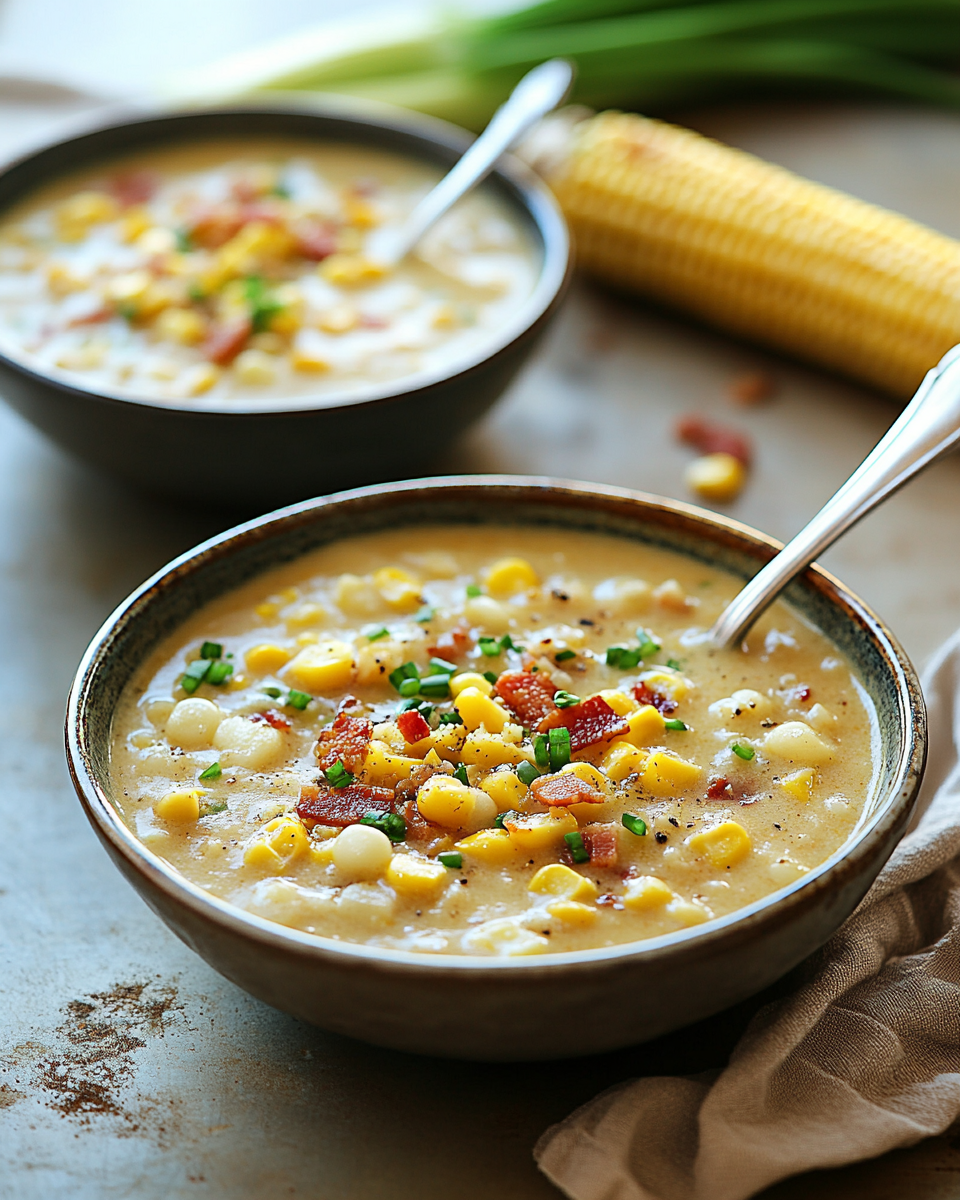A light, creamy, and flavorful chowder that’s perfect for showcasing sweet summer corn. This comforting soup is loaded with fresh vegetables and herbs, making it a seasonal favorite that’s both hearty and wholesome.
FULL RECIPE
Ingredients
- 4 cups fresh corn kernels (from about 5 ears)
- 1 tablespoon olive oil
- 1 medium yellow onion, diced
- 2 cloves garlic, minced
- 1 celery stalk, diced
- 1 medium carrot, diced
- 1 medium Yukon gold potato, diced
- 3 cups low-sodium vegetable broth
- 1 cup milk (or dairy-free alternative)
- ½ cup heavy cream (or coconut cream for dairy-free)
- ½ teaspoon smoked paprika
- ½ teaspoon salt (or to taste)
- ¼ teaspoon black pepper
- 2 tablespoons fresh chives, chopped
- Optional: crumbled bacon or dairy-free bacon bits for topping
Directions
- Heat olive oil in a large pot over medium heat. Add onion and sauté until translucent, about 4 minutes.
- Stir in garlic, celery, and carrot. Cook for another 3-4 minutes until slightly softened.
- Add diced potato and corn kernels, stirring well to combine.
- Pour in the vegetable broth and bring the mixture to a boil. Reduce heat and simmer for 15-20 minutes, or until vegetables are tender.
- Use an immersion blender to partially puree the soup, leaving some chunks for texture. Alternatively, transfer half of the soup to a blender and blend until smooth, then return it to the pot.
- Stir in the milk, cream, smoked paprika, salt, and pepper. Simmer for 5 more minutes to heat through.
- Taste and adjust seasoning as needed. Serve hot, garnished with fresh chives and optional toppings.
Nutritional Information
- Calories: 210
- Total Fat: 10g
- Saturated Fat: 4g
- Cholesterol: 20mg
- Sodium: 340mg
- Total Carbohydrates: 28g
- Dietary Fiber: 4g
- Sugars: 8g
- Protein: 5g
- Vitamin A: 60% DV
- Vitamin C: 20% DV
- Calcium: 10% DV
- Iron: 6% DV
The History of Corn Chowder
Corn chowder has roots in traditional American cuisine, particularly in regions where corn was abundant. Originating as a simple farmers’ dish, it evolved from Native American corn stews and early settlers’ adaptations. The chowder style became popular in New England, where dairy was commonly added to create a creamy texture. Over time, corn chowder has become a beloved comfort food enjoyed across the U.S., especially during the summer months when fresh corn is at its peak.
Why Fresh Corn is Essential
Using fresh corn kernels is key to achieving the vibrant, sweet flavor that defines summer corn chowder. Fresh corn provides a natural sweetness and crunch that frozen or canned corn cannot replicate. When corn is freshly cut from the cob, the sugars remain at their highest concentration, lending a bright, crisp taste to the soup. This freshness enhances the chowder’s overall texture and taste, making it a standout summer dish.
The Role of Vegetables in Flavor Development
Besides corn, other vegetables like onion, celery, carrot, and potato add layers of flavor and texture to the chowder. Each vegetable contributes a unique note: onions provide sweetness and depth, celery adds a subtle bitterness, carrots introduce earthiness, and potatoes bring creaminess and body. Together, they create a balanced, rich flavor profile that complements the natural sweetness of the corn.
Creaminess Without Overpowering the Corn
The cream and milk in corn chowder create a luscious texture that envelops the palate. The choice of dairy or dairy alternatives can affect the chowder’s richness. Heavy cream adds a velvety finish, while milk keeps it lighter. For those seeking a dairy-free option, coconut cream or almond milk work well, offering creaminess without masking the corn’s delicate sweetness.
The Importance of Seasoning
Seasoning is vital to enhancing the natural flavors in the chowder. Salt and pepper provide basic seasoning, but the addition of smoked paprika introduces a subtle smoky depth that elevates the dish. Fresh herbs like chives or thyme add brightness and contrast, balancing the richness of the cream. Proper seasoning ensures the chowder is flavorful but not overwhelming.
Nutritional Benefits of Corn Chowder
Corn chowder is not only comforting but also nutritious. Corn offers dietary fiber, essential vitamins like A and C, and antioxidants. The vegetables contribute additional fiber and nutrients, making the soup a wholesome choice. Depending on the dairy used, the chowder can provide calcium and protein as well, supporting a balanced diet while satisfying hunger.
Versatility of Corn Chowder
This soup is incredibly versatile. It can be served as a starter, a light lunch, or a hearty dinner when paired with bread or a salad. It can also be customized with additional ingredients such as bacon, bell peppers, or different herbs to suit personal preferences. Corn chowder adapts easily to seasonal changes and dietary restrictions, making it a flexible favorite in many kitchens.
Pairing Corn Chowder with Other Dishes
Corn chowder pairs well with a variety of sides and accompaniments. Crusty bread, garlic toast, or a fresh green salad complement its creamy texture. For a more filling meal, grilled chicken or a simple sandwich can balance the chowder’s richness. The soup’s mild sweetness also contrasts nicely with tangy or spicy dishes, making it a great addition to diverse menus.
The Science Behind the Texture
The texture of corn chowder is a critical part of its appeal. Partial blending creates a creamy base while preserving chunks of corn and vegetables, giving it a satisfying bite. The starch from potatoes helps thicken the soup naturally without needing flour or cornstarch. This combination of smoothness and chunkiness makes the eating experience more enjoyable and comforting.
How to Store and Reheat Corn Chowder
Corn chowder stores well in the refrigerator for up to three days. When reheating, it’s best done gently over low heat to avoid curdling the dairy. Stirring frequently helps maintain the creamy consistency. This makes corn chowder a great make-ahead meal option, perfect for busy days when you want something quick but nourishing.
Adapting the Recipe for Dietary Needs
Corn chowder can be easily modified to suit various dietary restrictions. For vegan or dairy-free diets, substitute cream and milk with plant-based alternatives like coconut or oat milk. Using vegetable broth keeps it vegetarian. For a lower-fat version, reduce or omit the cream and use skim milk. Gluten-free options are natural since the chowder typically contains no flour, unless thickened, in which case cornstarch can be used.
Seasonal Variations and Enhancements
While summer corn chowder shines with fresh corn, it can be adapted for other seasons by swapping in frozen or canned corn. Adding seasonal vegetables like zucchini in summer or sweet potatoes in fall can change the flavor profile. Herbs and spices can also be varied—try adding fresh basil or a pinch of cayenne for heat. These tweaks keep the chowder interesting year-round.
Conclusion
Summer corn chowder is a timeless, comforting dish that beautifully celebrates fresh corn. Its creamy, flavorful profile and nutritional benefits make it a perfect addition to any seasonal menu. Whether enjoyed as a simple soup or dressed up with extra ingredients, corn chowder remains a versatile, crowd-pleasing favorite. With easy adaptations for dietary preferences and seasonal availability, it’s a recipe that invites creativity while honoring classic flavors.






